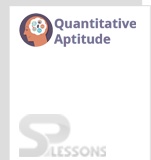 Introduction
Introduction
What is Quantitative Aptitude test?
Quantitative Aptitude is one of the prominent competitive aptitude subjects which evaluates numerical ability and problem solving skills of candidates. This test forms the major part of a number of important entrance and recruitment exams for different fields. The Quantitative Aptitude section primarily has questions related to the Simplification, Numbering Series, and Compound Interest, etc.
A candidate with quantitative aptitude knowledge will be in a better position to analyse and make sense of the given data. Quantitative Aptitude knowledge is an important measure for a prospective business executive's abilities.
The article TS CAB Recruitment Quantitative Aptitude Quiz 4 provides Quantitative Aptitude questions with answers useful to the candidates preparing for Competitive exams, Entrance exams, Interviews etc. The article TS CAB Recruitment Quantitative Aptitude Quiz 2 will assist the students to know the expected questions from Quantitative Aptitude.
 Quiz
Quiz
1. Ratan takes turns to cycle around the circular garden and through the diameter of the garden on alternate days. His speed each day is 6m/min but when he cycles through the diameter, he takes 1 hr less to cross the park. Find the diameter of the park.
- A. 1530 m
B. 1680 m
C. 1750 m
D. 3600 m
- A. 20 days
B. 24 days
C. 22.5 days
D. 37.5 days
- A. 30 litres
B. 75 litres
C. 96 litres
D. 110 litres
- A. 2008
B. 2009
C. 2010
D. 2011
- A. [latex]\frac {1}{36}[/latex]
B. [latex]\frac {2}{36}[/latex]
C. [latex]\frac {1}{6}[/latex]
D. [latex]\frac {1}{5}[/latex]
1. The average of first 19 multiples of 12 is
- A. 110
B. 110.5
C. 120
D. 220
- A. 6.25
B. 25
C. 50
D. 12.5
- A. 729
B. 765
C. 784
D. 812
- A. 24 years
B. 27 years
C. 30 years
D. 33 years
- A. 213444
B. 214344
C. 214434
D. 231444
1. A company pays 12.5% dividend to its investors. If an investor buys Rs.50 shares and gets 25% on investment, at what price did the investor buy the shares?
- A. 6.25
B. 25
C. 50
D. 12.5
- A. 12.4
B. 14
C. 16
D. 18.6
- A. 0.0001
B. 0.001
C. 0.01
D. 0.1
- A. 5: 6
B. 3: 4
C. 7: 8
D. 8: 9
E. None of these
- A. 15 days
B. 14 days
C. 13 days
D. 11 days





